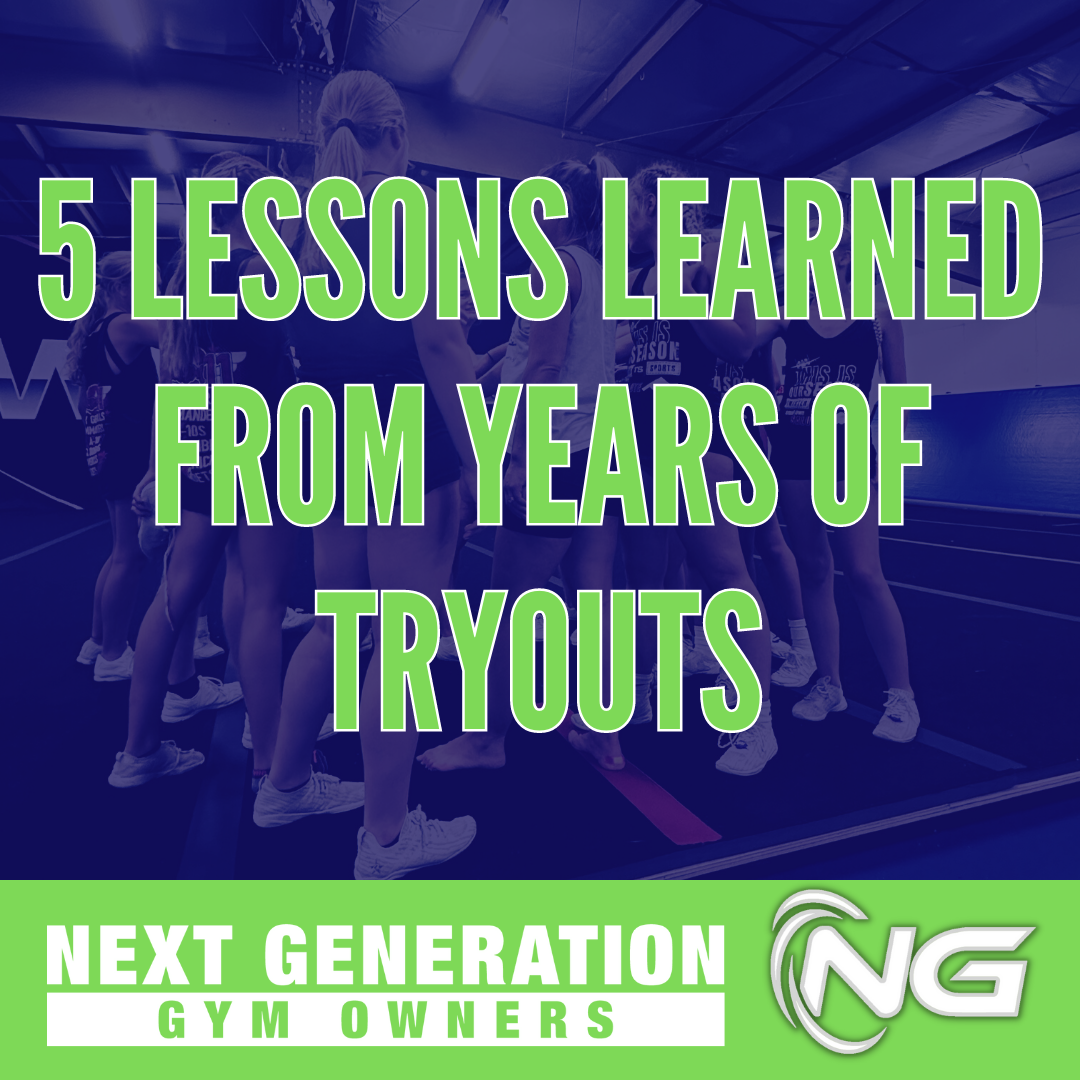Tryouts are THIS WEEK at my gym! (OK, if you listened to Dan’s podcast, you know I’m convicted by not calling it “Team Placements”. It’s a hard change, but I’m getting there! If you didn’t listen, it’s super interesting. Check it out here!)
Anyway, after all that time, I’ve learned a few lessons and I had to pass them on. If you have more, send them my way and I’ll add them to this blog!!
-
- Try your best to prepare parents in advance for any “surprises”. I know you gave them the rubric. You know they read it and said, “She has her standing handspring, but not a roundoff back handspring. She’s a level 2 anyway.” Oh cheer moms. I love them. I’m teasing of course. I understand they see how hard their child works and wants to reward them with levels based on effort. That’s not reality, but it’s the mama bear in them, and I can’t blame them. If you watch your fifth grader study SO HARD for their states test and they bomb it, you’re probably not too mad. In your mind, the effort earned an A. Unfortunately cheer doesn’t always work that way, so if you think a parent has an unrealistic expectation, be VERY clear what the athlete’s skills are and what age divisions and levels the athlete is eligible for. If you level the athlete up due to stunting or because you need so and so on a team, they can be pleasantly surprised.
- Don’t talk to angry parents. I mean, you’ll eventually need to talk to them, but give them 24 hours to cool off. Two years ago I told parents we’d release teams on Saturday and if they had questions or concerns, they could reach out on Monday. I got a call from a parent Saturday within 20 minutes of releasing teams. I knew her and thought, “There’s no way it’s about placements. Maybe she’s just panicking she didn’t get the email.” I was wrong. She was angry about making a particular team. In fact, that made her less angry than the fact that another athlete with similar tumbling made a crossover team of a higher level. The athlete she referred to was a fantastic base. Her daughter was a front spot with little interest in basing. (Look at me even justifying it to you 🤣) Anyway, I engaged in the conversation thinking I’d be able to talk her down. I listened. I responded. I got to listen again. I started to respond. Then I got to listen more. I didn’t take my own advice. By Monday, the athlete was registered for the same level at a gym in KC. The drive was so far that mom rented an apartment in the city so they would be closer to the gym. I didn’t know she had that in her. I also shouldn’t have engaged in the conversation while she was so angry. I was naive. Don’t be Danielle.
- Sell or be sold. Grant Cardone wrote this book and it spoke to me. Everything you do in life is a reality of persuasion. Either you’re persuading someone or they’re persuading you. So, I will tell you now. SELL your athletes on the level they should expect. I have a tryout Facebook group of all the parents and athletes who are trying out this season. Last week I posted an amazing level 1 routine I saw. This week I’ll post 2-3 more level 1 routines. Why? I’ve got 86 kids trying out who are level 1 athletes. I need to sell them on how great level 1 is. Me? I love level 1. It’s fun and every year I see more and more creative skills. I find the most creative and challenging routines and make sure our teams see those!
- Plan for rest after tryouts. We don’t take a lot of rest from our end of season event to tryouts, and your kids need rest. So, celebrate the new teams, bond a bit and then take a week or two break to just rest. The new season doesn’t have to start yet. You’ll be fine. If you didn’t read why rest is so important, check out my blog on that last week here.
- Overestimate the amount of time tryouts will take. I am a mom, so I am in the cheer moms groups. I recently saw someone genuinely asking why tryouts cost money. Well, they take an enormous amount of behind-the-scenes time. Especially this year as I revised tryout scoresheets to reflect the new scoresheets. We spent 12-15 hours revising last year’s scoresheets, adding a tryout application, revising the tryout application questions, hosting a live tryout meeting, two flyers’ tryout meetings, a followup tryout meeting (when the scoresheet changed), attending open gym as a staff to watch some additional out-of-level passes the kids had been working hard on, and now this week we’ll print and organize all of that. We’ll have four judges for tryouts for 8 hours and two admin people to help speed the process along. I’ll have a junior coach warming up littles so they can perform skills safely. We’ll then spend about 3 hours forming teams with our 114 athletes currently registered. Finally, we’ll prepare the emails and post the team graphics. There is SO MUCH involved in tryouts. I’ve estimated almost 30 hours with a staff of 3-6 at any given time. Even when I had a super small program 2 years ago with 28 kids, we spent a lot of time preparing. Don’t underestimate it and rush yourself because you committed to other things over the weekend. Think through everything, and enjoy the process. You’ll be living with your choices all year, so it’s worth taking your time here.
So, as we head into this week, take a deep breath and enjoy the process. It’s going to be stressful, but the start of something new is also so much fun.









